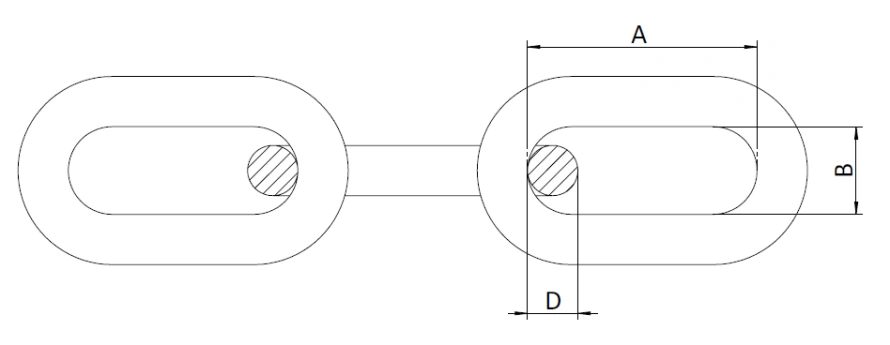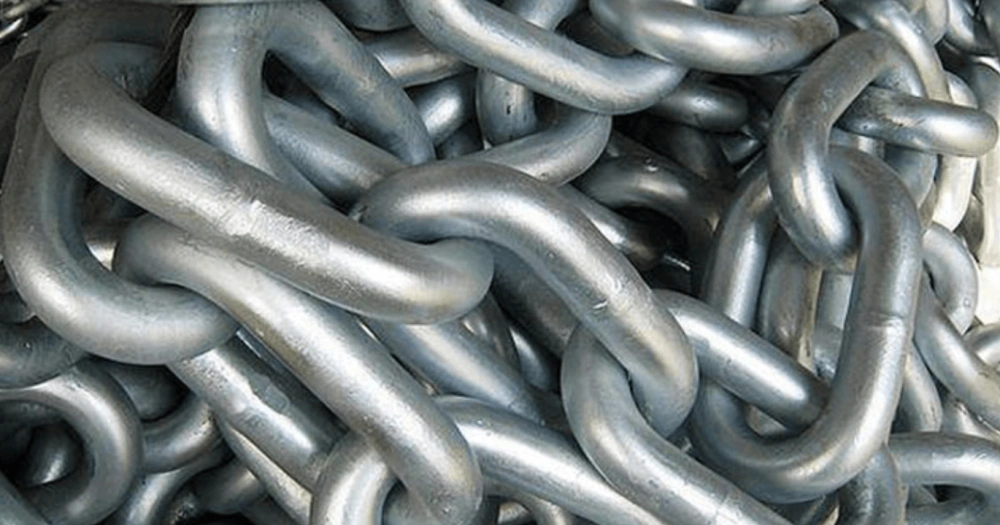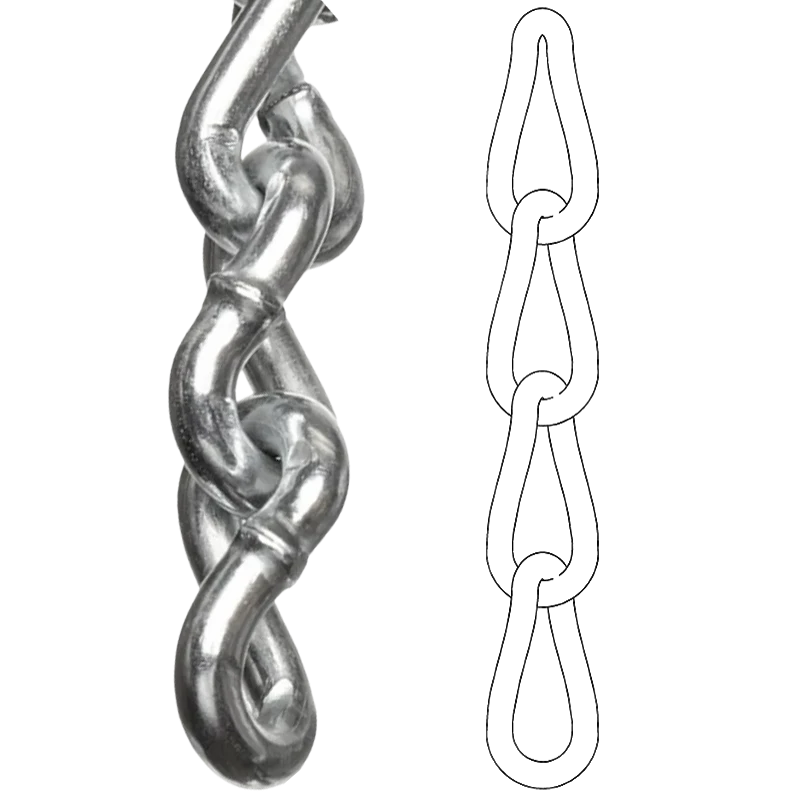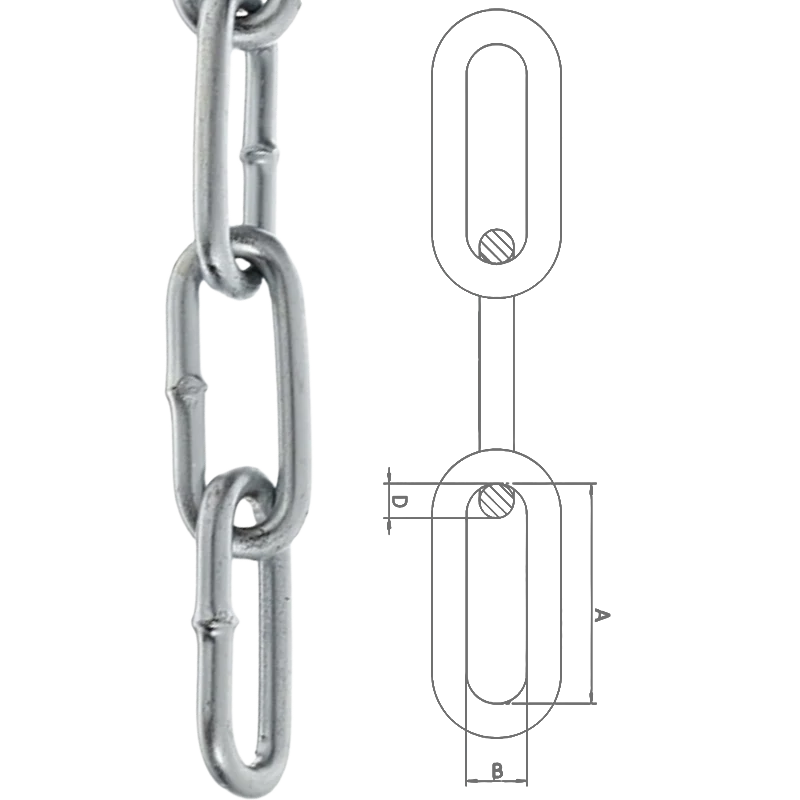DIAGRAMS

STUDLESS LINK CHAIN SPECIFICATIONS
| TESTING LOAD OF STUDLESS CHAINS | |||||||
| Dia. | BM1 (KN) | BM2 (KN) | BM3 (KN) | Weight | |||
| mm | Breaking Load | Proof Load | Breaking Load | Proof Load | Breaking Load | Proof Load | kg/m |
| 16 | 94.72 | 47.1 | 132.3 | 66.2 | 184.83 | 92.42 | 5.56 |
| 17.5 | 113.31 | 56.35 | 157.78 | 78.89 | 221.1 | 110.55 | 6.65 |
| 19 | 133.57 | 66.42 | 187.2 | 93.6 | 260.64 | 130.32 | 7.83 |
| 20.5 | 155.49 | 77.33 | 217.27 | 108.64 | 303.42 | 151.7 | 9.12 |
| 22 | 179.08 | 89.06 | 250.9 | 125.4 | 349.4 | 174.7 | 10.5 |
| 24 | 213.25 | 105.98 | 298 | 149.9 | 415.8 | 207.9 | 12.5 |
| 26 | 250.12 | 124.38 | 350.8 | 175.4 | 488 | 244 | 14.67 |
| 28 | 290.08 | 144.26 | 406.7 | 203.8 | 566 | 283 | 17 |
| 30 | 333 | 165.6 | 467.5 | 234.2 | 649.8 | 324.9 | 19.5 |
| 32 | 378.88 | 188.42 | 531.2 | 265.6 | 739.3 | 369.6 | 22.22 |
| 34 | 427.72 | 212.7 | 599.8 | 299.9 | 834.6 | 417.3 | 25.08 |
| 36 | 479.52 | 238.46 | 672.3 | 336.1 | 935.7 | 467.8 | 28.12 |
| 38 | 534.28 | 265.7 | 748.7 | 374.4 | 1042.5 | 521.3 | 31.33 |
| 40 | 592 | 294.4 | 829.1 | 414.5 | 1155.2 | 577.6 | 34.72 |
| 42 | 652.68 | 324.58 | 915.3 | 457.7 | 1273.6 | 636.8 | 38.28 |
| 44 | 716.32 | 356.22 | 999.6 | 502.7 | 1397.8 | 698.9 | 42.01 |
| 46 | 782.92 | 389.34 | 1097.6 | 548.8 | 1527.8 | 763.9 | 45.92 |
| 48 | 852.48 | 423.94 | 1195.6 | 597.8 | 1663.5 | 831.7 | 50 |
| 50 | 926.09 | 460 | 1293.6 | 648.8 | 1805 | 902.5 | 54.25 |
DESIGN
MATERIAL
- Galvanized Steel, AISI 316 Stainless Steel, or Carbon Steel
WARNING
- This chain is not suitable for lifting purposes.
FINISH
- Hot-Dip Galvanized
- Painted/Coated
- Electro-Galvanized
STANDARDS
- ISO standards
APPLICATION
- Specifically designed for anchoring applications on ships and vessels.
CUSTOMIZATION
- Available
INSTRUCTIONS & CAUTIONS
WORKING LOAD LIMITS: This is the maximum load a chain should ever handle, even when it’s new and the load is evenly distributed along a straight, untwisted length. The “working load limit” doesn’t reflect the load the chain could potentially endure if conditions like wear, twisting, misuse, overloading, or corrosion are introduced. These factors can reduce the chain’s strength, so regular inspections are crucial to ensure safety.
PROOF TEST: This is the load a chain undergoes before leaving the factory. The chain is tested under direct tension in a straight line at a consistent speed using a standard testing machine. The purpose of this test is to identify any material or manufacturing defects.
All stud link chain,studless anchor chain and mooring chain are proof tested. are proof tested. When using attachments like hooks or rings, make sure they match the chain’s grade, type, and size for proper load-bearing performance.
OUR ADVANTAGES
Tailored Customization
We provide custom ISO standard studless link anchor chain to fit your specific needs. Whether it’s size, material, finish, or strength grade, we’ve got you covered. This flexibility makes our chains ideal for everything from industrial to agricultural and marine applications.
Built to Last
Our chains are made from high-quality materials like carbon steel and stainless steel, designed to perform under tough conditions. They resist corrosion, handle heavy use, and keep working long-term, no matter how demanding the environment.
Industry-Approved
All our chains are made to meet ISO standards and other relevant certifications, so you can trust their safety and reliability. We ensure that every chain performs to the highest specifications, keeping you compliant with industry regulations.
Great Value with Bulk Discounts
Get the best value for your money with our competitive pricing and bulk discounts for large orders. We make sure you get a great deal without compromising on the quality of our ISO standard studless chain .
FAQ
What is a studless anchor chain?
A studless anchor chain is a type of chain commonly used in marine and anchoring applications. It’s designed without internal studs, making it more flexible than studlink chains. Studless chains are typically used in environments where flexibility, ease of handling, and moderate strength are needed. They’re resistant to corrosion and wear, ensuring reliable performance in harsh marine conditions.
Stud link vs studless chain : Which is better for anchoring?
Both studlink and studless chains are used for anchoring, but studlink chains are stronger and more rigid, making them better suited for heavy-duty anchoring in rough seas. Studless chains, on the other hand, are more flexible and easier to handle, making them suitable for smaller vessels or less extreme anchoring conditions. The choice depends on the specific needs of your anchoring system.
Are studless anchor chains suitable for lifting applications?
Studless anchor chains are not designed for lifting heavy loads. They are intended for anchoring and securing vessels in place rather than lifting. For lifting applications, you should use chains specifically rated for lifting purposes, like Grade 80 or Grade 100 alloy chains, which are designed for safe, dynamic load-bearing.
Can studless anchor chains be used in saltwater environments?
Yes, studless anchor chains are ideal for saltwater environments. They are made from corrosion-resistant materials such as galvanized steel or stainless steel, making them resistant to the effects of saltwater. This ensures a long service life and reliable performance without degradation from rust or corrosion, which is crucial for marine and offshore applications.
Are studless anchor chains customizable in length?
Yes, studless anchor chains can be customized to your required length. Whether you need a shorter chain for a small vessel or a longer chain for larger ships, we offer customization options to meet your needs. Custom lengths ensure that the chain fits your anchoring system perfectly, providing better control and performance in all conditions.
How should I maintain a studless anchor chain?
-
Regular Inspections: Check for wear, corrosion, and damage regularly to ensure the chain remains in good condition.
-
Wash with Fresh Water: Periodically wash the chain to remove salt buildup, especially after exposure to saltwater.
-
Apply Rust Inhibitor or Lubricant: Use a light coat of rust inhibitor or chain lubricant to maintain smooth operation and prevent corrosion.
-
Proper Storage: When not in use, store the chain properly to extend its lifespan and protect it from environmental damage.
Are studless anchor chains compatible with all anchors?
Yes, studless anchor chains are compatible with most types of anchors, provided that the chain’s size and strength are appropriate for the anchor’s requirements. The chain can be connected to the anchor using shackles or rings, making it adaptable to various anchoring systems, ensuring secure attachment and effective holding power.
What are the benefits of using a studless anchor chain over a studlink chain?
The main benefit of studless chains is their flexibility and ease of handling. Unlike studlink chains, which are stiffer and harder to manage, studless chains are more adaptable and easier to store. They are ideal for lighter-duty anchoring, where flexibility and ease of use are more important than maximum strength. Studless chains are also typically lighter, making them easier to deploy.
What certifications do studless anchor chains have?
Studless anchor chains are often certified by international standards organizations such as RINA, BV, or Lloyd’s Register. These certifications ensure that the chain has been tested for safety, durability, and performance under the harshest conditions. Certified chains give you peace of mind that you are using equipment that meets the highest industry standards.




